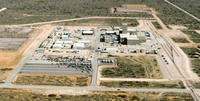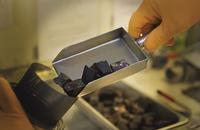-
Guard fired for Y-12 breach says he was made a scapegoat for contractor’s failings
Kirk Garland, a security guard at the Y-12 National Security Complex in Oak Ridge, Tennessee, was fired from his job two weeks after three aging peace activists, led by an 82-year old nun, managed, on 28 July 2012, to breach the facility’s supposedly impregnable perimeter security systems, then loiter, unnoticed, on the grounds of the facility, where bomb grade uranium is stored. The activists had enough time to spray-paint peace messages and Bible verses on walls, slosh the walls with human blood, and wrap one of the buildings with crime-scene tape. In an arbitration hearing, Garland argued that he was made a scapegoat for the larger failings of the then-security contractor,Wackenhut Services.
-
-
New Mexico demands clarifications, reassurances on WIPP radiation leaks

New Mexico’s environment secretary Ryan Flynn has ordered the Department of Energy (DOE) to explain how it will protect public health and the environment while it investigates a radiation leak at the underground Waste Isolation Pilot Plant (WIPP). The plant has not been in compliance with various permit requirements since the February underground fire and radiation leak, which eventually led to a plant shutdown.
-
-
Problems continue to plague the Oxide Conversion Facility at Y-12

Oxide conversion is critical to recycling weapons-grade uranium, making it useful in nuclear warheads or for other purposes. The Oxide Conversion Facility (OCF) at the Y-12National Security Complex has been operating inconsistently in recent years. A report by the staff of the Defense Nuclear Facilities Safety Board(DNFSB) said there was a plan to resume operations the week of 7 April 2014, but that did not happen.
-
-
Sandia completes overhaul of key nuclear weapons test facilities
Sandia National Laboratories recently completed the renovation of five large-scale test facilities that are crucial to ensuring the safety and reliability of the U.S. nuclear weapons systems. The work supports Sandia’s ongoing nuclear stockpile modernization work on the B61-12 and W88 Alt, assessments of current stockpile systems and test and analysis for broad national security customers.
-
-
South Carolina withdraws MOX lawsuit against DOE, NNSA
The state of South Carolina said Friday that it would not go ahead with its lawsuit against the Department of Energy and the National Nuclear Security Administration (NNSA) in support of the Savannah River Site’s Mixed Oxide (MOX) Fuel Fabrication Facility. The dismissal of the lawsuit follows an announcement last Tuesday by the DOE and NNSA that construction will continue on the MOX facility through the end of the fiscal year. The two agencies made it clear, though, that they still plan to mothball the plant.
-
-
Lawmakers want DOE to reduce run-away costs of S.C. plutonium processing plant
Lawmakers have given the Obama administration two weeks to submit a plan for reducing the cost of constructing the mixed-oxide fuel conversion (MOX) facility which would convert bomb-grade plutonium into nuclear fuel. The MOX facility at the Savannah River Site, South Carolina was launched to help the United States meet its nuclear arms reduction agreement with Russia, and agreement which called for the two countries to dispose of at least thirty-four metric tons each of weapons-grade plutonium.
-
-
Access of Russian surveillance craft to U.S. airspace questioned
Under the Treaty on Open Skies (OS), signed in 1992 and ratified in 2002, thirty-four nations allow the protected passage over their territory of surveillance aircraft from other OS signatory member states, aircraft featuring advanced sensory equipment that allow for the monitoring of arms controls compliance and troop movements. With rising U.S.-Russia tensions over Ukraine, and with information emerging about a new Russian surveillance aircraft model equipped with the most advanced surveillance capabilities, U.S. government officials and lawmakers question whether OS-related Russian surveillance flights over the United States should continue.
-
-
S.C. fights to keep costly plutonium processing project alive
The United States and Russia have agreed to dispose of thirty-four tons of weapon-grade plutonium each, an amount equal to 17,000 nuclear warheads. The United States budgeted $4 billion for a mixed-oxide fuel project, known as MOX, at the Savannah River Site, S.C., to process the plutonium, but construction costs have now reached $8 billion, and officials estimate the facility will cost about $30 billion over its operating years. DOE has suspended the MOX project and is looking for alternative plutonium processing methods. South Carolina has sued the federal government, arguing that since Congress has authorized the funds for MOX, the administration must spend the money.
-
-
Detecting and defeating radiological threats
Brookhaven National Laboratory’s Radiological Assistance Program (RAP) team works to stay ahead of any radiological threats by using many detection tools that have become increasingly sophisticated and user-friendly. During a deployment, researchers and technicians with backgrounds in various aspects of radiological controls and analysis conduct field monitoring and environmental sampling, assessment, and documentation activities to help decision makers choose appropriate protective actions for the safety of both the public and first responders.
-
-
Nuclear cooperation with non-NPT member states debated
The United States, Britain, and the Czech Republic have all backed a Dutch paper tied to the meeting last week of the Nuclear Suppliers Group (NSG) which urges closer ties with nuclear-capable countries outside of the Treaty on the Non-Proliferation of Nuclear Weapons (NPT), including Israel, Pakistan, and India. Opponents of the Dutch proposal say it would legitimize the proliferation of nuclear weapons, while supporters say the proposal merely recognizes reality.
-
-
NC State awarded $25 million NNSA grant to launch nuclear proliferation detection effort
North Carolina State University was awarded a 5-year, $25 million grant by the National Nuclear Security Administration’s (NNSA) to develop the next generation of leaders with practical experience in technical fields relevant to nuclear nonproliferation. The new Consortium for Nonproliferation Enabling Capabilities, or CNEC, aims to be the pre-eminent research and education hub dedicated to the development of enabling technologies and technical talent for meeting the challenges of nuclear nonproliferation in the next decade.
-
-
New detection technology to help combat nuclear trafficking
According to the International Atomic Energy Agency (IAEA), the greatest danger to nuclear security comes from terrorists acquiring sufficient quantities of plutonium or highly enriched uranium (HEU) to construct a crude nuclear explosive device. The IAEA also notes that most cases of illicit nuclear trafficking have involved gram-level quantities, which can be challenging to detect with most inspection methods. Special algorithm coupled with commercial X-ray scanners allows detection of small amounts of fissile materials in luggage.
-
-
Red Team’s concepts, approach gain support
Headed by Thom Mason, director of Oak Ridge National Laboratory (ORNL), Red Team aims to modernize the uranium processing procedure on a budget of $4.2 billion to $6.5 billion. Even before Red Teamdelivered its report on alternatives to the expensive Uranium Processing Facility (UPF) at the Y-12 nuclear weapons plant by the 15 April 2014 deadline, the group of experts, who come from different disciplines, had already gained support among energy officials and some members of Congress.
-
-
Improving the aerodynamic design of B61-12 bomb
Sandia National Laboratories has finished eight days of testing a full-scale mock unit representing the aerodynamic characteristics of the B61-12 gravity bomb in a wind tunnel. The tests on the mock-up were done to establish the configuration that will deliver the necessary spin motion of the bomb during freefall and are an important milestone in the Life Extension Program to deliver a new version of the aging system, the B61-12.
-
-
Lt. Gen. Frank Klotz (Ret) confirmed as DoE undersecretary for nuclear security, NNSA administrator
Lieutenant General Frank G. Klotz, United States Air Force (Ret.), was confirmed by the Senate on Tuesday, 8 April 2014, as the Department of Energy’s undersecretary for nuclear security and administrator for the National Nuclear Security Administration (NNSA).
-
- All
- Regional
- Water
- Biometrics
- Borders/Immig
- Business
- Cybersecurity
- Detection
- Disasters
- Government
- Infrastructure
- International
- Public health
- Public Safety
- Communication interoperabillity
- Emergency services
- Emergency medical services
- Fire
- First response
- IEDs
- Law Enforcement
- Law Enforcement Technology
- Military technology
- Nonlethal weapons
- Nuclear weapons
- Personal protection equipment
- Police
- Notification /alert systems
- Situational awareness
- Weapons systems
- Sci-Tech
- Sector Reports
- Surveillance
- Transportation
Advertising & Marketing: advertise@newswirepubs.com
Editorial: editor@newswirepubs.com
General: info@newswirepubs.com
2010-2011 © News Wire Publications, LLC News Wire Publications, LLC
220 Old Country Road | Suite 200 | Mineola | New York | 11501
Permissions and Policies
Editorial: editor@newswirepubs.com
General: info@newswirepubs.com
2010-2011 © News Wire Publications, LLC News Wire Publications, LLC
220 Old Country Road | Suite 200 | Mineola | New York | 11501
Permissions and Policies
